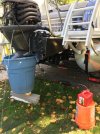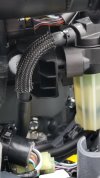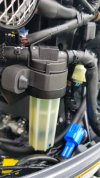DiamondDave952
Well-Known Member
- Messages
- 137
- Reaction score
- 160
Happy Saturday!
I was wondering if someone in the community would have a picture of how the fuel line (with bulb) is connected to the motor? Is the hose secured via a hose clamp or a crimped on connection? I am a few hours away from where the pontoon and would save me a trip. I want to fog my motor and watched a few YouTube videos on how to do so. Most videos show mixing the YamaLube Fogging Oil in a small gas can and running a separate fuel line from the gas can to the motor. However, the videos don't show how they removed the fuel line that is on the boat. Thank you!
I was wondering if someone in the community would have a picture of how the fuel line (with bulb) is connected to the motor? Is the hose secured via a hose clamp or a crimped on connection? I am a few hours away from where the pontoon and would save me a trip. I want to fog my motor and watched a few YouTube videos on how to do so. Most videos show mixing the YamaLube Fogging Oil in a small gas can and running a separate fuel line from the gas can to the motor. However, the videos don't show how they removed the fuel line that is on the boat. Thank you!





